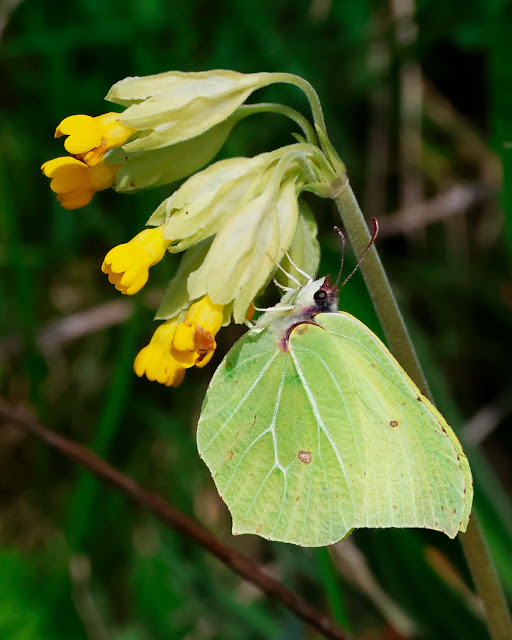Beacon Hill is one of several hills along the South Downs that afford wonderful views down and out across the Solent and the Isle of Wight. The nearest hill being Old Winchester and it was interesting to get a view of a more familiar site.
While waiting for Ian to arrive a Nuthatch entertained in the car park.
WE left the car park and walked south alongside a copse, eventually coming out into the open and some amazing views.
A group of four Ravens flew over, coming quite close.
You go through a gate and then you come across a view down and out looking south and east. Cowslips were all over the grass.
The wind was very cold, coming from the north, but in the shelter of the bushes the sun was now warm and there were pockets of warmth. In one of these Ian found, what must be a recently emerged Green Hairstreak.
We left the car park and headed back down to Warnford. There are a series of watercress beds alongside the A32 that are no longer in use, I slowed down to check for possible Green Sandpiper, Ian pulled over and I did like wise and he pointed out a Grey Wagtail on the basin.
A Female preening.
Walking around the reserve too start there was no sign of any butterflies, but there were Early Purple Orchids.
As we reached mid day we finally started to see some butterflies, my first Green-veined White of the year.
In the pit at the far end of the reserve we searched for the Duke without any luck, this is usually the best area to find them. Walking around I came across a male Brimstone resting on Cowslips while the sun was behind the clouds.
As we left the pit, we came across a Holly Blue, another first for the year. It settled on some blossom again while the sun was again behind the clouds.
We decided to have lunch while the sun continued to warm up the grass areas, sitting around I was taken by the Cowslips around me.
After lunch we decide to walk around the reserve once more, but we did not get far as we came across a couple who pointed out a Duke of Burgundy for us. We have been looking for these delightful little butterflies every year at this time for twelve years, and here were were again looking at a smart male.
I rushed over and we took it in turns to move the heather to get a clear view. The Emperor moth is a hairy moth that is grey-brown with big
peacock-like eyespots on all four wings and pinky-red markings at the wingtips.
It is the only large moth with eyespots on all four wings. The smaller, eyed
hawk-moth, has two large eyespots on the hindwings only. The moth was just showing the orange hindwing and eye spot.
The spectacular Emperor moth is Britain's only resident
member of the Saturniidae family. It is reasonably common over much of Britain,
occupying moorland and open country.
The males, which have bright orange hindwings, the females are much greyer, fly
during the daytime in search of the greyer females, which fly at night. Both
sexes are on the wing in April and May.
Males can be seen flying swiftly about and can be mistaken
for butterflies. The females rest in low vegetation during the day, releasing the
pheromones to attract males. Which is what we did to attract this male.
They zig zag low across open ground; an urgency born from
limited energy stored as a caterpillar. Lacking mouth parts to feed, they are
on borrowed time, time to be invested solely in searching for their Empress.
We walked around the common, but did not come across any more moths. There were plenty of Linnets about, showing well at the top of the gorse.






















































No comments:
Post a Comment